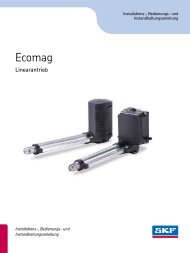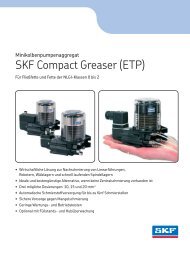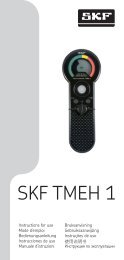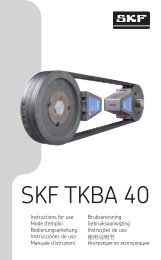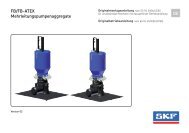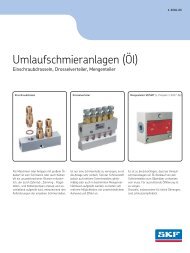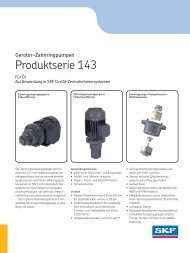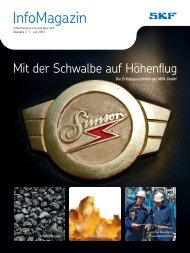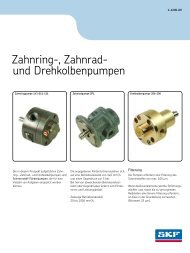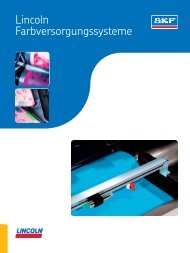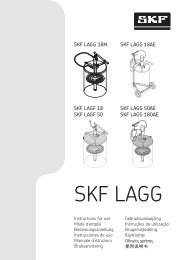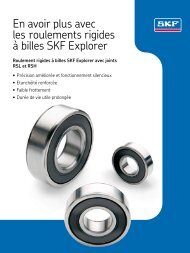SKF Timing Belt Kits - SKF.com
SKF Timing Belt Kits - SKF.com
SKF Timing Belt Kits - SKF.com
Create successful ePaper yourself
Turn your PDF publications into a flip-book with our unique Google optimized e-Paper software.
Frequently asked questions<br />
Q: Tensioners and idler pulleys<br />
sometimes look the same.<br />
Can I interchange?<br />
A: You should only fit part numbers<br />
specifically shown for that<br />
application. Automotive engines<br />
each have their own particular<br />
performance characteristics,<br />
which means that tensioner<br />
and pulleys are designed and<br />
tested specifically for each new<br />
motor. The exterior appearance<br />
of the bearing unit may hide<br />
internal changes that have taken<br />
place to meet the change in<br />
engine specification, i.e., grease<br />
performance, bearing clearance,<br />
tolerances, tensioner spring<br />
strength.<br />
Q: Can I refit an old timing belt?<br />
A: NO. Used belts should not<br />
be refitted and used. The original<br />
belt has already been in use<br />
at its optimized tension, so<br />
the properties of the belt have<br />
changed <strong>com</strong>pared with a new<br />
belt.<br />
Q: The tensioner is showing<br />
external corrosion but is rotating<br />
freely. Is it okay?<br />
A: Change it. If the belt is being<br />
changed, then it is possible this<br />
unit will need to be functioning<br />
on the car for another 60,000<br />
mi/96 560 km. Don’t take the<br />
risk: internal condition and<br />
bearing life cannot be seen.<br />
Q: How often should a <strong>com</strong>plete<br />
timing belt and tensioner change<br />
be carried out?<br />
A: Most car manufacturers including<br />
NISSAN, FORD, HONDA, and<br />
CHEVROLET specify <strong>com</strong>plete<br />
repairs to their models during a<br />
specified service period. Outside<br />
this period the system should be<br />
checked for damage. Or if<br />
you are in doubt about the<br />
condition of <strong>com</strong>ponents, you<br />
should re<strong>com</strong>mend a <strong>com</strong>plete<br />
change to your customer.<br />
74<br />
Q: There are many brands<br />
of timing belt kits available.<br />
Why should I use <strong>SKF</strong>?<br />
A: <strong>SKF</strong> was the first <strong>com</strong>pany<br />
to launch this concept, and since<br />
then has continued to use its OE<br />
manufacturing experience to lead<br />
the market with OE approved<br />
<strong>com</strong>ponents in <strong>SKF</strong> branded<br />
boxes.<br />
Q: What’s the main benefit<br />
to our repair shop for using<br />
timing belt kits?<br />
A: You will be more efficient, having<br />
the necessary <strong>com</strong>ponents in one<br />
box. You will also have the ability<br />
to promote a professional image<br />
to your customers in terms of<br />
quality of work and service. The<br />
end result is higher customer<br />
satisfaction and a stronger<br />
business.<br />
Specific removal and installation<br />
instructions by make, model and<br />
year included in each kit.<br />
Q: Can I buy the tensioner<br />
or pulleys on their own?<br />
A: Sometimes you will only be<br />
required by the customer to<br />
change the pulley or tensioner,<br />
so for flexibility we offer an<br />
extensive range for our customers.<br />
Q: What is the difference<br />
between a timing belt kit<br />
and a multi-V belt kit?<br />
A: The timing belt kit is used<br />
on timing system in which<br />
the crankshaft drives the<br />
camshaft(s) and actuates<br />
the valves via a timing belt.<br />
The multi-V belt kit is used<br />
on auxiliary drives in which<br />
the crankshaft drives auxiliary<br />
<strong>com</strong>ponents such as the<br />
alternator, air conditioning<br />
<strong>com</strong>pressor, power steering<br />
pump etc., via a multi-V belt.<br />
Q: What is a belt tensioner unit?<br />
A: The belt tensioner unit sets the<br />
right belt tension and provides<br />
guidance for the belt.<br />
Q: What is the difference<br />
between a BTU and an<br />
Automatic BTU?<br />
A: The adjustment of tension during<br />
mounting is achieved by means<br />
of an eccentric or by means of a<br />
spring acting against a contact<br />
pad on the bracket.<br />
Q: What is an idler pulley?<br />
A: The idler pulley is fixed and<br />
allows the belt to be correctly<br />
wound around the driven<br />
<strong>com</strong>ponents.<br />
Q: How can I check the belt<br />
tensioner?<br />
A: A belt tension testing device that<br />
ensures proper tension of the belt<br />
after mounting should be used.<br />
Q: What are the main causes<br />
of belt damage?<br />
A: Too high or too low tension,<br />
vibrations, high temperature and<br />
belt misalignment.<br />
Q: Why is it re<strong>com</strong>mended to<br />
also change belt tensioner<br />
and pulleys when the belt is<br />
repaired?<br />
A: The main source of the belt’s<br />
damage has most definitely<br />
affected the other rotating<br />
<strong>com</strong>ponents of the timing<br />
and auxiliary systems, like the<br />
BTU, Automatic BTU and idler<br />
pulley. To allow a <strong>com</strong>plete and<br />
safe repair for the engine, <strong>SKF</strong><br />
re<strong>com</strong>mends changing the belt<br />
and the belt tensioner pulleys at<br />
the same time.



